History of Newport Pagnell services
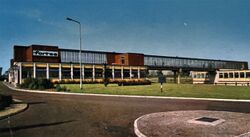
The northbound side in 1960.

Newport Pagnell is the oldest motorway service area in the country - although it doesn't like to admit it. This page explains how it was built.
Decision
See also: The Original Five
After the Ministry asked potential operators which of the five potential M1 service areas would be best, it was decided they would be at Redbourn and Watford Gap. This left a large gap between facilities, so it was decided to build a forecourt at Newport Pagnell.
In a last-minute twist, residents objected to the Redbourn plan, so with little time left it was decided to build a full service area at Newport Pagnell instead.
As another late change, it was decided to put a maintenance compound in the service area, reducing the already small plot allocated to it.
Tendering
64 interested firms were sent details of the planned service area in April 1959, and six responses were received. The tenders needed to show two transport cafés, one restaurant, a filling station and a repair bay. They were examined by the motorway's engineers, alongside experts in finance and catering.
The minimum spend allowed on the service area was £50,000 (around £1million in 2025), and there had to be at least 12 fuel pumps across three islands on each side, with at least 12 toilets. The government agreed to fund a bridge with a roof on condition it was at right angles to the road.
Messrs Wildman & Partners
This design came from a catering firm who had no garage experience and little financial backing. It was at least a good building design, with considerable detail, and a good layout. It showed a two-storey restaurant with space for expansion.
Their investment was good but not good enough, their proposed rent formula was good but only if you assumed sales would be low.
Banquets of Oxford Ltd
The traffic flow in this plan was described as "tortuous", with petrol by the entrance. Sir Owen Williams criticised it as for not leaving space for expansion, calling it "inflexible".
Airborne Catering (Southend-on-Sea Ltd)
Airborne submitted a good design, but the firm couldn't demonstrate much experience. Their building designs scored well even if they were a bit small, and their traffic layout was poor.
John Jordan
This design was clearly more interested in the petrol station, with all traffic directed through it. It had a restaurant at bridge-level (not making clear whether it would be on the bridge or just next to it). Their design work was otherwise good.
British Electric Traction Investments Ltd
BET's rent offer was particularly poor. Their design was clever because it was mostly car parking, which the Ministry would be paying for.
They proposed small buildings with a transport café separated within the main café. Their specification was not particularly detailed.
Motorway Services Ltd
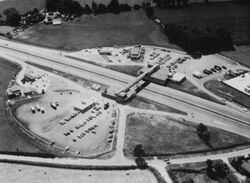
Motorway Services Ltd were a union between Fortes and Blue Star which arose during the early consultation phase, with both firms keen to promote their own names. Their rent offer was average, with the new company evidently being short of funds.
The design was clearly aiming to impress wealthy motorists. They had ignored the requirement to have two transport cafés and instead proposed two cafés to seat 200 each - the same thing but with a more classy name, as it was actually barely a snack bar. The northbound side also had a restaurant at the south end which was expensive and American-styled, serving food at counters and tables.
They were proposing to spend £250,000 on the project (about £5million in 2025). The buildings were to be positioned close to the road, with the footbridge given glass walls and incorporated into the design to link the two. Fortes proposed a glass roof and picnic tables so motorists could enjoy the exciting view of speeding traffic. The northbound side was also supposed to have an outdoor dining terrace next to the road.
The building design scored well, even if the toilets were hard to find. Outside, symmetry was key, with both forecourts at the southern end and parking areas at the north. Shops were provided close to each entrance, along with a store, toilets and a workshop.
The southbound building was positioned about one metre from the new motorway, while the northbound restaurant was somehow even closer. This was different to the design chosen for Watford Gap, but it wasn't considered a down-side, in fact it was in-keeping with the Ministry's vision for an exciting motorway.
As they were one of the largest organisations to bid, Motorway Services Ltd impressed with their offer, and won the bid. Their architect was Sydney Clough, Son & Partners.
Construction
With little time left before the motorway opened, the Ministry asked Blue Star to get an emergency petrol station ready as soon as possible. They managed to get something described as "reasonably attractive" open on 2 November 1959 with a recovery truck, a small filling station and a temporary toilet block. Fuel was available from Shell, Esso, Regent, Mobil and Fina. No rent was charged during this period.
Once that was open, attention turned to the permanent buildings. With staff working overtime Fortes could have been ready to get the amenity building open by April 1960, but the Ministry wouldn't have been ready with the car parks in time. The footbridge was fitted on 3 April 1960, using one of the first weekend motorway closures.
The site of the service area was larger than initially envisaged, causing the Ministry to exceed their £300,000 budget (about £6million in 2025). There was also confusion about the bridge: the Ministry had said they would pay for a roof, but Fortes had interpreted this as them paying for it to be fully enclosed. The Ministry reluctantly agreed to do this, requiring roadworks on the motorway and consultation with the Royal Fine Art Commission, pushing costs up further.
The contractor was J Laing.
Opening
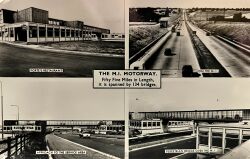
On 15 August 1960 the northbound café opened. With the footbridge not ready, southbound traffic was allowed to use the rear access and Little Linford Lane to access the new restaurant. The northbound Grill & Griddle restaurant opened on 17 August 1960, and the larger southbound services and footbridge opened on 30 September.
Fortes were under strict instruction to make the building dull and to separate it from the main carriageway with a lot of trees. When the government came to make their final inspection, they found that both rules had been broken and the site was seen as a "possible distraction" to drivers. Despite this, the service area continued as normal and like most service areas, it has since attracted much more gaudy advertising.
Under the rules at the time, advertising should have only promoted Motorway Services Ltd, but an exception was made to allow both the Fortes and Blue Star names to feature.
Forte News, 1960.
200 staff were employed to work at the service area. They were mostly local and mostly female, as Fortes' internal newspaper remarked in a special edition celebrating the opening of the service area.
Fortes were allowed to apply for a licence to serve alcohol with food. This application was rejected, which generated considerable negative publicity. The operator argued their fine-dining would never be successful if alcohol couldn't be served. Motorway service areas were soon forbidden from applying for alcohol licences, while Fortes later created a de-alcoholised wine for their customers at Newport Pagnell.
Operation
Egon Ronay, 1961
The service area was almost immediately seen as being too small: on 12 November 1960 - less than three months after opening - they were drawing up plans to double the number of toilets provided.
Even today, it is crammed into the local area, however the northbound site has sprawled into the field next to it. The same isn't true for the southbound side which has a huge shortage of space. Recent development means that the northbound site won't be able to expand any further either. In addition, the decision to build so close to the motorway has created numerous maintenance issues.
Toddington was proposed almost immediately to relieve Newport Pagnell, and treated like an extension of Newport Pagnell, although Fortes did not win that contract. Even with the help of Toddington, by 1969 the restaurants at Newport Pagnell were running 20% over capacity.
The toilets had an attendant, as well as free towels and electric hand drier (all novelties at the time). The parking was criticised for being "messy".
There was a serious incident at the service area on 7 March 1976, when an IRA bomb was planted in a holdall left in the southbound car park. AA patrolman Charlie Hough spotted the device and moved it away from the building. It detonated 10 minutes later, causing no injuries but damaging nearby vehicles. There was another bomb scare on 20 June 1989; the building was evacuated but this threat turned out to be untrue.
An estimated £120,000 of damage (about £340,810 in 2025) was caused by an arson attack early on the morning of 16 August 1987. It happened at the Julie's Pantry on the southbound side, which was broken into. The fire brigade were then called to a small electrical fire in the Little Chef in July 1994, and there was another fire on the roof of the southbound building in August 1995.
Entry Slip
As early as 1960, both Motorway Services Ltd and Autocar Magazine were complaining about the southbound entry to the service area, calling it dangerous. The problem seemed to be that it had a slight curve in it, but no physical obstruction to highlight it. The northbound side was actually much shorter, but because it clearly entered the petrol station, people knew to slow down.
As the service area has been expanded, that entrance has become necessarily much sharper. While it is better signed than it used to be (and motorists are now more aware of how to enter a service area), it still stands out as a historical anomaly on the upgraded M1.
The most well-known incident occurred in September 2007 when a coach overturned on the bend, injuring 30 people.
Early Changes
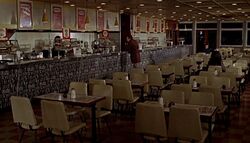
Due to a lack of space and changes in demand, the service area quickly moved away from fine dining. The snack bar was converted to a café with a large, carpeted room with fixed wooden seating by Formica-topped tables, overlooking the motorway. There was an Italian-tiled area by the servers and slot machines lined the narrow entrance. Beans on toast was sold for 1s8d (around £2 in 2025).
The restaurant has moved through phases of favourable and unfavourable reviews; Egon Ronay was initially impressed.
The housing estate right next to the southbound service area was built in 1962. At the time there were very few houses so close to motorways. Initially the houses sold well, but the residents quickly moved out and few wanted to replace them. Strangely, Blue Boar had wanted to build their own houses at Watford Gap.
By the 1990s the northbound side was larger of the two, with a Little Chef restaurant and a Thorntons shop. There was a Granary on each side but northbound was larger, and the only one to open all night. Significant refurbishments took place on both sides, including new forecourts and new parking areas. The southbound forecourt is still in roughly the same position as it has always been (albeit with new island), while the northbound forecourt has been moved. A KFC was added to the northbound side.
Administration
In the 1960s, Fortes wanted to build a lorry park near Milton Keynes. This and the service area would have then been able to promote and relieve each other, and the lorry park would have had the additional benefit of being outside the government's tight regulations.
Despite the service area initially being a hit with new motorists, internally Motorway Services Ltd were causing concern for the Ministry because they were slow to deal with problems and had a habit of ignoring regulations. There was some frustration over the rear access, which wasn't being locked and, according to the management, was being abused by "rowdy people".
When the service area opened it formed the head office of certain segments of the Forte business, and today Welcome Break's head office is only a few miles away in the nearby suburb.
M1 Widening
It was announced in 1989 that the M1 would be widened between J10 and J15. At the time, widening normally involved building a whole new motorway. An internal report said that the project was "certain to have a significant impact" on the service area, and suggested it may be best to re-locate it.
When the roadworks eventually did happen in 2019, it was done on a much smaller scale and only very minor changes were needed at the service area's slip roads. As part of the work, a new concrete barrier was provided to protect the northbound building, but the southbound building still has a standard steel one, despite traffic now being just a metre away.
30 Years
In September 1990 Fortes invited Prime Minister Margaret Thatcher to an event celebrating 30 years of motorway service areas. The Ministry of Transport warned Fortes about such an event, claiming it was a breach of their contract. Cecil Parkinson MP instead attended a much-scaled down event, although traffic congestion made him run late and a speech about the future of the motorway network was ironically cancelled. According to the press release, a time capsule was buried in the northbound service area, although no other record of this has been kept.
Welcome Break held a series of family events to mark the site's 65th birthday during August 2025.
Hotel Building
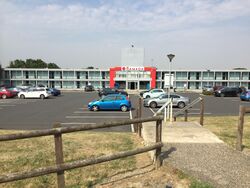
Newport Pagnell had one of the first hotels on the motorway network. Although it is immediately adjacent to the main service area, it's built on land that is technically not part of it. For this reason it was exempt from many of the motorway service area regulations, which made the Department of the Environment uneasy.
The hotel was thought to have opened in 1971 with 98 bedrooms. It used a building style that was inspired by American motels, including bedroom doors that opened directly onto the car park. It was branded TraveLodge and covered a huge plot of land; larger than the northbound amenity building, with a long driveway and a huge garden. A strange parking area was provided at the edge of the service area, which meant the large hotel car park didn't get used to its full potential either. It had a gym and a breakfast bar. Egon Ronay called it "shabby" during his 1989 visit.
After Welcome Break split from Granada, the Newport Pagnell hotel was rebranded Welcome Lodge. Many of these were soon changed to Days Inn, but Newport Pagnell hung on, perhaps because of its ageing building.
The hotel hosted the wedding of Chris and Susan Hallett. The happy couple, who had spent a lot of time on the roads, commented on its "convenient" location for their families, though it had to get a licence and find a minster for the ceremony.
In 2004 there was a plan for the hotel to be rebuilt in a new location in the south-west corner, allowing the old land to be sold for housing, but this didn't happen. The Welcome Lodge finally became Days Inn in April 2009. Another proposal, dated 2012, sought to demolish the hotel and replace it with a more space-efficient building, again selling the land around it for housing, where residents would have their own walking and bus route through to the service area.
The hotel was rebranded again in June 2016, reopening as a Ramada after extensive refurbishment work, including building a conservatory over the bedroom doors. Instead of demolishing it, the housing estate Rowditch Furlong was built around the hotel in 2021, leaving the service area with a much smaller garden (but still more than you'll find anywhere else here).
Survey Results
In 2025, Which? Magazine ranked Newport Pagnell 71st out of the 90 service areas they visited.
The 2022 Transport Focus survey calculated a 90% satisfaction score for the northbound service area, and 89% for the southbound service area, placing them both in the lower quarter. The following year these scores had risen to 95% and 90% respectively, but grade inflation meant that they remained in the lower quarter.
In Spring 2021, Which Magazine calculated a 41% satisfaction score for the service area, placing it 3rd-from-bottom.
In Spring 2018, Transport Focus calculated a 92% satisfaction score for the northbound services and 81% for the southbound services. In 2019 this changed to 88% and 89% respectively.
In 2015 and May 2012, VisitEngland rated the services as 3 stars. In August 2011, they gave the northbound services as 2 stars and the southbound side 3 stars.
In 2008 the services won a five star loo award.
In 2007, Newport Pagnell northbound won a five star loo award. The southbound side won a four star one.
In 2006, both sides of Newport Pagnell won a four star loo award.
Also in 2006, Holiday Which? rated the services at 2/5.
It was here in 2000 that Egon Ronay supposedly made his infamous breakfast review, "it's called 'all day' because it tastes as if it had been hanging around all day". In the actual report he attributed the quote to a colleague.
Also in 2000, The AA rated the services as "acceptable".
In 1991, a Which? survey recommended the services.
Egon Ronay's 1990 guide graded it as "good".
A Holiday Which? review in 1980 said the place was "showing its age", with food that was "average".
Egon Ronay's 1978 review called the restaurant "unacceptable" and the cafeteria "appalling". He described stale fish fried in old fat, gristly meat, rubbery pastry, watery carrots and shrivelled peas.
A 1978 government review described the services as "crowded and grubby".
In 1977 Egon Ronay rated the services as "just acceptable", saying it looked worn and made heavy use of pre-cooked food.
In 1961 Egon Ronay was full of praise for Newport Pagnell, telling motorists they could "stop with confidence". This favourable opinion did not last long.